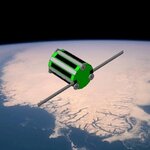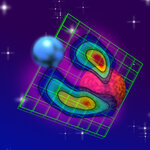Space

I enjoyed presenting on Project Calliope two weeks ago, at the 215th AAS meeting. I have a partial podcast of my talk in preparation, but in the meantime, here are the visual slides from my presentation (and also up as a PDF at ProjectCalliope.com. The most important theme I covered was the shift from a tech mindset (build a crack engineering team) to a social mindset (gather a circle of interested people able to talk this up). Though the value of the talk was in the dialog, not the slides, this does provide a useful basic primer on the how and why of launching a…

Wednesday 6 January 2010
There have been only two standing ovations at the AAS in his memory, said Society president John Huchra, and the other heralded a presenter who later won the Nobel Prize.
That’s how astronaut John Grunsfeld’s invited talk ended Wednesday morning. Grunsfeld flew on the recent Atlantis mission to service the Hubble Space Telescope, whose newest photos have renewed for many the awe Hubble images inspire. Despite significant obstacles, including stuck parts and having to loosen several dozen tiny screws while wearing spacesuit gloves, the mission was a…

University of Iowa (UI) astronomers have made the first clear, rainbow-like, radio telescope images of a distant stellar coronal loop, at the eclipsing, non-nova binary star Algol, found in the constellation Perseus.
This famous variable star's name derives from Arabic Ras al Ghul (meaning "head of the demon") so Algol is often called the Winking Demon Star. Algol's 68.75 hour wink, discernible by the naked eye, exhibits an extra dimming blink, probably caused by a third star orbiting very close to Algol's second star companion, making this a triple-star system.
Artist's conception of Algol'…
The European Southern Observatory (ESO) has just released a new image of NGC 6334, an emission nebula discovered by astronomer John Herschel in 1837 and dubbed the Cat's Paw Nebula.
This new portrait of the Cat's Paw Nebula was created from images taken with the Wide Field Imager (WFI) instrument at the 2.2-metre MPG/ESO telescope at the La Silla Observatory in Chile, combining images taken through blue, green and red filters, as well as a special filter designed to let through the light of glowing hydrogen.
NGC 6334 lies about 5500 light-years away in the direction of the…

Tuesday, 5 January 2010
There are several ways to spot an exoplanet. The two most common are the radial velocity and transit techniques. Radial velocity measurements detect changes in the star’s light due to its back-and-forth motion in response to its planet’s gravitational tug. RV observations and astrometry—similar idea, but you can actually see the star move, not just detect the motion in its light spectrum—have brought us the bulk of exoplanet discoveries (nearly 400) and provide a minimum mass estimate for the planet.
Transits, on the other hand, occur when a…

You can (and should) listen to my first ever podcast, at "365 Days of Astronomy", which is either about a) why we put telescopes on mountains and in space or b) why science in Antarctica rocks! From the 365DOA site:
Ever wonder why astronomers loft telescopes higher and higher, to mountains and via balloons and satellites? Astrophysicist Sandy Antunes explains, and in the process gets an accidental lesson from a Linda Banish, a rock-climbing colleague, on why Antarctica is the best place in the world for science.
What made this fun was when my co-host, Linda, got onto a wonderful…

I am not one for New Year's resolutions. January 1st does not particularly stand out to me, frankly. This year, however, I felt the need to turn over a new leaf. And so, amongst the various changes I wish to undertake in my semi-professional life, I have decided to actually give regular attention to this blog. (No promises for thesis deadline weeks, however.)
You may notice that January is well on its way to completion. The first week of January I was otherwise detained, interviewing researchers at the 215th meeting of the American Astronomical Society in…
Where are we? Cosmically, I mean. We have barely made steps to get to the edge of our solar system, via Voyager 1 and 2. It's ironic that we can see back 13 billion years using telescopes, but we have little idea of what 'stuff' is out there-- matter, dark matter, energy. Or even what is just outside our local solar system.
The Voyager probes sensed strong magnetic fields near the edge of our solar system, and earlier Interstellar Boundary Explorer (IBEX) results supported that. IBEX is in a high-altitude highly elliptical Earth orbit that helps it get above the…

I just posted a tweet storm from this week's 215th AAS Conference. The specific session was a workshop on "Astronomy Employment: Past and Future". The panelists were Beryl Benderly (Science Careers journalist), Rachel Ivie (AIP), Jim Ulvestad (NRAO), and Steve Beckwith (Univ. of CA), and their opinions were both frank and highly welcome at dispelling illusions about the ivory tower of academia.
This is the cold, hard reality of professional astronomy, presented from the inside. Here are the quotes and tweets from the workshop.
"More people are beign qualified as scientists…

Researchers at the American Museum of Natural History and the University of Cambridge have developed models they say explain how earth survived its birth. Presenting their findings at the 2010 meeting of the American Astronomical Society in Washington, D.C., the team suggests that variations in temperature can lead to regions of outward and inward migration that safely trap planets on orbits. When the protoplanetary disk begins to dissipate, planets are left behind, safe from impact with their parent star.
During the birth of a star, a disk of gas and dust forms. The midplane of this…